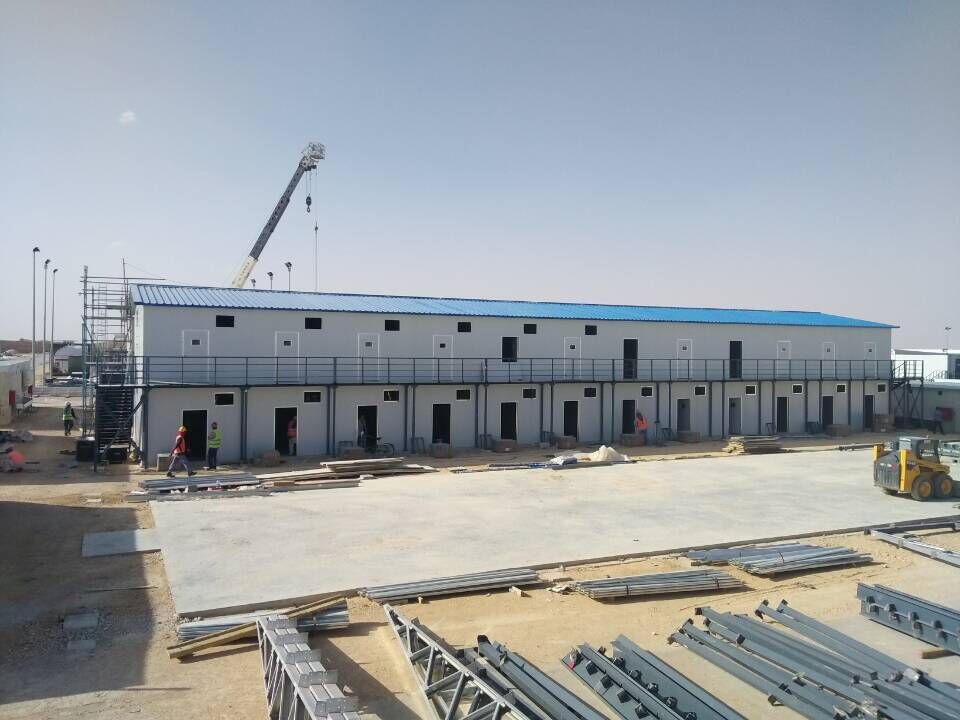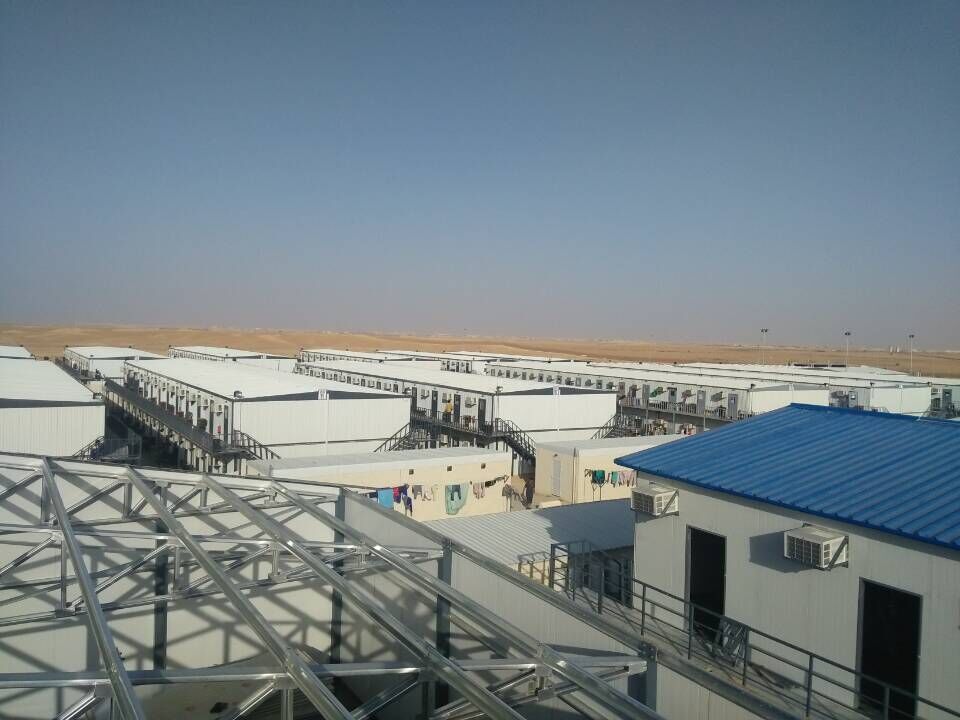Tel: 0086-532-88966982
0086-532-88965892
Website: www.lidajituan.com
E-mail: sales@lidajituan.com
Head office: 5th Floor, Building A, Dalen Center, 180 Haier Road, Qingdao, 266000, China
The 2025 Mining Playbook: How Prefab Building Tech Solves Remote Site Housing Crises
Classification:Industry News
Release time:2025-07-08 12:00
The 2025 Mining Playbook: How Prefab Building Tech Solves Remote Site Housing Crises
Deep in Zambia’s copper belt, a revolution is unfolding not in the pit but above ground. At First Quantum’s Sentinel Mine, 1,800 workers now inhabit a community assembled in 5 months—a task requiring 22 months by conventional methods. This acceleration isn’t luck; it’s the product of prefab building technologies redefining how miners conquer housing shortages in the world’s most isolated frontiers. As 2025 dawns with intensified production pressures and ESG scrutiny, industrial-scale modular houses emerge as the strategic linchpin resolving mining’s most persistent bottleneck: livable, scalable infrastructure where none exists.
Anatomy of a Crisis: Why Traditional Solutions Collapse
Mining’s remote housing dilemma stems from converging pressures:
- Labor Inflation: Australian drill crew costs surged 63% since 2020
- Scope 3 Deadlines: 72% of miners face binding 2030 carbon reduction targets
- Ore-Grade Decline: New deposits demand 38% more personnel per tonne extracted
- Social License Wars: Ghana and DRC mandate 90% local hiring—requiring immediate housing
Conventional responses crumble under scrutiny:
Prefab’s Triple-Play Solution Engine
Lida Group’s engineered systems attack these failures through three integrated vectors:
1. Hyper-Accelerated Deployment Mechanics
Operationalizing barren terrain in <180 days
- Parallelized Workflows: While crews drill foundations in Mongolia, Guangdong factories laser-cut steel frames for 300-bed campuses
- Flat-Pack Logistics: Panelized systems ship 62% more beds per convoy versus volumetric modules
- Robotic Precision: Welding arms achieve 0.2mm tolerances—eliminating on-site fitting delays
Result: BHP’s Jansen Phase 2 deployed 850 beds in Nunavut before winter freeze—a feat impossible with concrete.
2. Lifetime Cost Dominance
42% TCO reduction over decade-long horizons
- Material Science: Galvanized steel substructures outlast site-built concrete 3:1
- Energy Arbitrage: Aerogel-insulated panels cut HVAC loads 60% in Kazakhstan’s -40°C winters
- Relocation Equity: Bolivia’s San Cristobal mine redeployed modules 3 times over 15 years
Financial Impact: Rio Tinto saved $140M at Oyu Tolgoi through redeployment versus rebuilds.
3. ESG Integration Layer
Embedding sustainability into structural DNA
- Carbon Engineering: Low-emission steel trusses slice embodied carbon 54%
- Water Autonomy: Onboard filtration recycles 85% of greywater in Chilean deserts
- Community Enablement: South African platinum mines train locals in modular assembly—creating skilled jobs without fly-in experts
Data Point: Anglo American’s Quellaveco project achieved carbon-neutral camps using integrated solar roofs and Lida’s thermal bridging tech.

The 2025 Tech Stack: Beyond Four Walls
Tomorrow’s mining camps function as integrated biospheres:
- AI Microgrids: Self-optimizing systems balancing solar/wind/diesel—reducing fuel burn 70%
- Health Informatics: Air quality sensors triggering ventilation when particulates exceed thresholds
- Dynamic Floorplans: Reconfigurable walls adapting buildings from accommodations to clinics as needs shift
- Drone Logistics: Autonomous resupply networks replacing hazardous truck convoys
Lida’s Pilots Underway:
- Nevada lithium sites testing hydrogen-ready power hubs
- Guinea bauxite camps with predictive maintenance AI
- Canadian Arctic deployments using phase-change thermal batteries
Case Blueprint: Solving the Andean Housing Emergency
Challenge: A major copper expansion in Peru’s Andes needed 1,200 beds at 4,200m elevation. Logistics constraints limited deliveries to 16-ton trucks on winding roads. Winter closures imposed a 147-day deadline.
Traditional Failure Mode:Site-built approach would miss deadline by 11 months → $2.1B production delay

Why Lida Defines the New Standard
Miners consistently choose this China supplier for mission-critical deployments because they engineer outcomes rather than structures:
- Radical Transparency: 3D digital twins allowing virtual walkthroughs pre-shipment
- Extreme Certification: Seismic Zone 4 and Cyclone Region D compliance baked into core designs
- Supply Chain Armor: Vertical control from steel coil sourcing to final assembly
- Lifecycle Algorithms: Predicting maintenance windows years before failures
The Strategic Imperative for 2025
The calculus has irrevocably shifted:
- Traditional Builds = Capital traps consuming 18-24% of pre-production budgets
- Lida Prefab Ecosystems = Strategic accelerators compressing time-to-revenue
As Freeport CEO Richard Adkerson observed after deploying 3,000 Lida beds across Papua New Guinea: "Our modules became profit centers—each day saved put $400K EBITDA in play."
In mining’s new era—defined by decarbonization pressure, remote mineral discoveries, and hyper-competitive talent wars—the operators who thrive will be those whose housing solutions don’t just shelter workers, but actively drive operational superiority. The playbook is clear: transform camps from cost centers to competitive weapons through industrialized modular innovation. Those still pouring concrete in 2025 aren’t building mines—they’re constructing their own obsolescence.
prefabricated house,prefab building,modular house,prefab house
Contact Us
Head Office: 5th Floor,Building A,Darron Center,No.180,Haier Road,Qingdao, 266000,China
Tel: 0086-532-88966982 88965892 Fax:0086-532-88965571
WhatsApp:+86 13793209022
Mobile/Wechat:+86-15166671720
Email: sales@lidajituan.com Website: www.lidajituan.com
Alternate Website: www.lidamodularhouse.com
Head Office: 5th Floor,Building A,Darron Center,No.180,Haier
Road,Qingdao, 266000,China
Tel: 0086-532-88966982 88965892
Fax:0086-532-88965571
Email: sales@lidajituan.com
Website: www.lidajituan.com
Alternate Websit: www.prefabhousecn.com
Wechat/WhatsApp:+86-13793209022
Copyright(c)2023 All Rights Reserved SEO Business license

